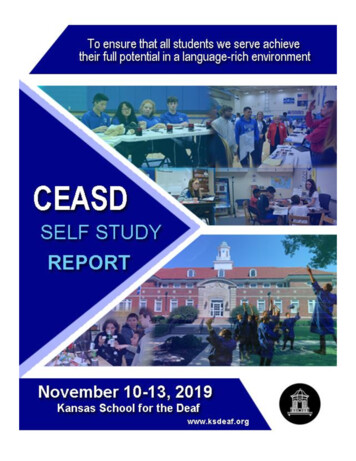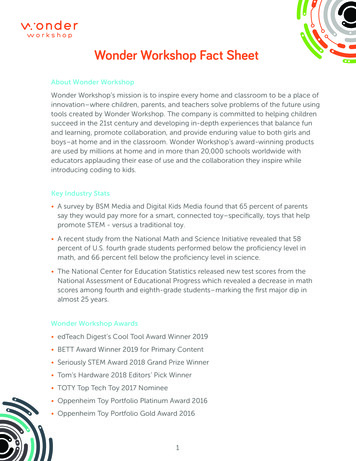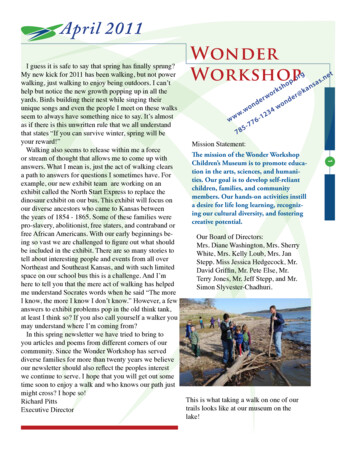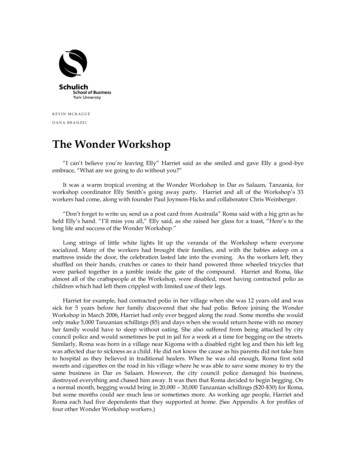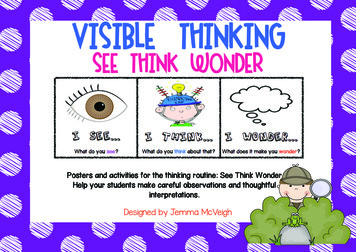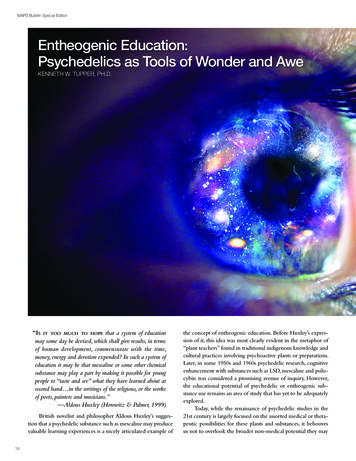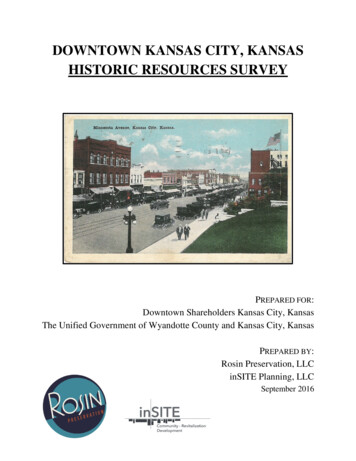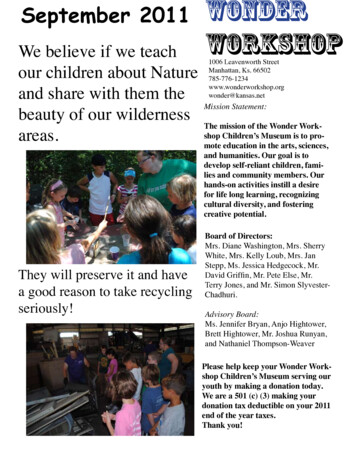
Transcription
September 2011We believe if we teachour children about Natureand share with them thebeauty of our wildernessareas.They will preserve it and havea good reason to take recyclingseriously!WonderWorkshop1006 Leavenworth StreetManhattan, Ks. as.netMission Statement:The mission of the Wonder Workshop Children’s Museum is to promote education in the arts, sciences,and humanities. Our goal is todevelop self-reliant children, families and community members. Ourhands-on activities instill a desirefor life long learning, recognizingcultural diversity, and fosteringcreative potential.Board of Directors:Mrs. Diane Washington, Mrs. SherryWhite, Mrs. Kelly Loub, Mrs. JanStepp, Ms. Jessica Hedgecock, Mr.David Griffin, Mr. Pete Else, Mr.Terry Jones, and Mr. Simon SlyvesterChadhuri.Advisory Board:Ms. Jennifer Bryan, Anjo Hightower,Brett Hightower, Mr. Joshua Runyan,and Nathaniel Thompson-WeaverPlease help keep your Wonder Workshop Children’s Museum serving ouryouth by making a donation today.We are a 501 (c) (3) making yourdonation tax deductible on your 2011end of the year taxes.Thank you!
The Evolution of Jocko GravesThe physical transformation of Jocko Gravesmore than 200 years ago. By Richard PittsI was taught by my elders that there are two typesof alarm clocks: one woke you up in the morningso you wouldn’t be late for school or an appointment; the second clock went-off in your head whensomething really important had happened thatyou won’t soon forget. This second kind of alarmwent off one Sunday afternoon in my parents car.My mother commented about a statue of a BlackMan sitting in the front yard of a White neighbor’shouse as we drove past. Momma said somethingto the effect of, why do White People continue tohave those degrading statues of Black people intheir yard, don’t they know slavery is over.Without muttering another word I took this tomean that all Whites who have this black statue intheir yard must not like Black People.In 2011, I know that this is not true since I’vecome to know many people who carry on traditionspassed down to them without really knowing theretrue meaning and how it makes other people feel.For example, when I was in the military my roommate had a confederate flag in our room. I askedhim why he had the flag, didn’t he know what thatflag represented to African Americans? His answerwas that the flag only identified him with beingfrom the South which he was proud of. Needlessto say we had a very long conversation about slavery, the Civil War and Jim & Jane Crow that didn’tchange his mind nor mine. Which brought me tothe realization that some people know and don’tcare who gets hurt by their family traditions.In 1995 while doing research on the Underground Railroad in Kansas I came across a shocking story about the “Jocko Graves” statue. Thestory goes that when George Washington crossedthe Delaware one cold winter night a young Blackkid named Jocko Graves was with him. Becausethe boy was young old George asked him to staywith the horses until they came back from fightingthe Red Coats and to hold the lantern so they couldfind their way back.When Washington came back Jocko hadfrozen to death with lantern in hand. Inhonor of his dedication to the war andfreedom George Washington commissioned a statue in his image. The statuecan be seen above that was createdsometime around 1776. However there isno written record of this account in anyof George Washington’s papers but thestory has been passed down orally sincethen to the present.The story doesn’t end there. During thetime period between 1840 to 1865 Jockowas reborn. This time the statue wasused by Underground Railroad agentsthroughout the country.If Jocko held a green ribbon in the ringhe was holding, this gave the signal ofa safe house for runaways. If the clothwas red this meant that the house wasbeing watched by pro-slavery people.This too has not been documented fromwritten records but has been passeddown through the Underground Railroadgrapevine.Since 1776 to the present old Jocko hasmade a few physical changes. In 1860the statue took on an unflattering lookwhich suggested Black People were buffoons. Most people only know of thislatter degrading image that representsto most African Americans the 400 yearstruggle to wipe out White Superiorityideology. FYI
The loss of the Kansas Art Commission and what it means for us. By Kate TaylorRecently I had the privilege to talk to a few influential members of our art community about theloss of the Kansas Art Commission and what it means for our community. I talked with PennySenften from the Manhattan Arts Center, Kathrine Walker Schlageck from the Beach Museum,and Jay Nelson from the Strecker-Nelson Gallery. Each are directly effected by the loss of theKAC (Kansas Art Commission) and these affects unfortunately will trickle down and affect theelementary school children that our community serves. Before I talk about the affect of losingthe KAC, I first want to go over what the KAC was.The KAC was founded in 1966. It served the people of Kansas through grants to organizations and support of artists. Arts and culture organizations, schools and colleges, libraries, andrecreation and parks programs are just some of the agencies that benefited from the Kansas ArtsCommission.The mission of the Kansas Arts Commission was to provide opportunities for the people ofKansas to experience, celebrate and value the arts throughout their lives. It was funded throughthe Kansas legislature and the National Endowment for the Arts. The Kansas Arts Commissionwas committed to finding ways to support and nurture the growth of arts in all Kansas ccommunities. In addition to its grant-making, the Kansas Arts Commission offered workshops,seminars and conferences that assisted organizations and artists in building capacity, growingaudiences and developing the vital business skills necessary to achieve success in the arts in the21st century. The KAC sought partnerships with local, regional and national leaders in the artsand – together with the Kansas Historical Society, the Kansas Humanities Council, the KansasFilm Commission and the State Library of Kansas – it was a member of the Governor’s Councilof the Arts and Culture. ( HYPERLINK ks.gov/mission.shtml)In other words the KAC gave money to local art programs to benefit the communities.At the Beach museum I talked with Kathrine who is the senior educator. When asked howthe loss of the KAC is affecting them, she outlined what the KAC had previously provided forthem. The grants that they received from the KAC went to helping children and their families.The money allowed the Beach to provide thousands of children tours, free family workshops,art supplies for the children tours, and buses to transport the children to the Beach during theschool year. Without this funding, Kathrine no longer has the opportunity to have each schoolvisit the Beach each year, sometimes numerous times. “No matter how good and how useful ourprograms are, the schools can not get here”.Kathrine is hopeful that with other grants she will be able to continue to provide buses forthe schools but that takes time. She previously had not applied for many outside grants becauseshe received them from the KAC and did not want to take money from other organizations.Now she is left with little choice. She must apply for other grants to continue the high qualitywork with our children, but these grants take time to come into effect. Also many of the deadlines for the grants that she would have applied for had already passed when the KAC becameno more. By this I mean the KAC still exists but only in theory. It has a volunteer board and anew leader but they do not have a staff, an office, or any government funding.
When I went to the Manhattan Arts Center I talked with Penny Senften. Penny runs MAC andhad also received grants from the KAC. They had previously had 3 different grants that helpedthem cover operating costs, a display celebrating the Kansas Sesquicentennial and takingprograms to the schools. Penny is hopeful that with more fundraising and applying for othergrants, they will be able to operate the same as usual. The thing that will affect MAC the mostis the loss of the professional development workshops provided by KAC. These workshopshelp develop management skills as well as offer the opportunity to get together and talk withothers in the art community. These workshops were free of charge, you only needed to provideyour own transportation.Penny has a passion for art but did not have all the training needed and the workshops helpedto guide her as well as countless others. Also, the KAC helped provide accountability for theorganizations. The Arts in Education grant helps provide better programs for the communitiesand the KAC helped grant writers with their lesson plans to ensure that their goals matchedtheir outcomes. The services were invaluable to many people.Finally I had the opportunity to talk with Jay Nelson from the Strecker-NelsonGallery. Jay was and continues to be a commissioner on the KAC. While talking to Jay hecleared up a lot of the preconceived notions that I had. I was under the impression that theKAC was closed due to funding this is not true. The KAC was to receive 792,000 whichis only 1/4000th of the budget. Also they were set to receive addition funds through the National Endowment for Arts (almost 1 million) as well as the Mid-American Arts Alliance( 400,000). Unfortunately, our governor saw fit to do a line item veto which caused the KACto receive no funding. To say that the lack of funding was the reason for the downfall of theKAC is a lie, the reason for the downfall of the KAC is that our governor opposes the NationalEndowment for the Arts and does not believe that the government should be funding the arts.After the line item veto, the governor fired the staff of the KAC and closed their offices.The funding from the KAC was not for artists, commercial use, or to make people rich.“This was not handouts, this was money to help people help themselves” (Jay Nelson). Themoney went to art organizations, to people who educate about the arts, and to programs toeducate. The money went to underwrite experimental theater and violin lessons. This moneywas for the less fortunate that would have not been exposed to art without the aid of the KAC.First and foremost the KAC wanted to help educate and to help enhance the lives of everyonethrough art.This is not a direct quote, but a senior manager at Boeing said at a conference I attended lastmonth that Boeing used to recruit its engineers from Korea and Japan because they could notfind innovative engineers in the USA. In keeping with the CEO’s credo (above) and to helprectify that situation, 20% of their (very substantial) charitable donations now fund arts education.“GE hires a lot of engineers. We want young people who can do more than add up a string ofnumbers and write a coherent sentence. They must be able to solve problems, communicateideas and be sensitive to the world around them. Participation in the arts is one of the bestways to develop these abilities.”Clifford V. Smith, President of the General Electric Foundation
“We are a company founded on innovation and believe the arts, like science and engineering,both inspire us and challenge our notions of impossibility.”George David, Chairman and Chief Executive Officer, United Technologies Corporation“The arts foster creativity, and creativity is central to our business strategy. Indeed, we believethere is a strong link between the creativity nurtured by the arts and scientific creativity. If ourscientists are stimulated through their involvement with the arts, then it’s ultimately good forour business and our community.”Randall L. Tobias, Chairman of the Board and CEO, Eli Lilly and Company“A good well-rounded education must include the study of both the arts and the sciences. As acompany we explore the synergies between arts and science. Of all subjects, the arts and sciences are the closest and most interrelated. They offer complementary ways of understandingthe same object or event. They also teach critical thinking, creativity and curiosity - skills thatmake for an educated and innovative work force.”Helge W. Wehmeier, President and Chief Executive Officer, Bayer Corporation“The rapidly evolving global economy demands a dynamic and creative workforce. The artsand its related businesses are responsible for billions of dollars in cultural exports for thiscountry. It is imperative that we continue to support the arts and arts education both on the national and local levels. The strength of every democracy is measured by its commitment to thearts.”Charles Segars, CEO of Ovation“We need people who think with the creative side of their brains - people who have played ina band, who have painted - it enhances symbiotic thinking capabilities, not always thinking inthe same paradigm, learning how to kick-start a new idea, or how to get a job done better, lessexpensively.”Annette Byrd, GlaxoSmithKline“Arts education aids students in skills needed in the workplace: flexibility, the ability to solveproblems and communicate, the ability to learn new skills, to be creative and innovative, andto strive for excellence.”Joseph M. Calahan, Director of Cooperate Communications, Xerox CorporationMichele and Robert Root-Bernstein from Michigan State University researched the correlationbetween the arts and innovation and conclude:“The data our scientists and engineers provided to us demonstrates that the more arts and craftsa person masters, the greater their probability of becoming an inventor or innovator. . Hobblethe arts and crafts and you hobble innovation. Hobble innovation and our economy will suffer. Conversely, invest in arts and crafts and every dollar will stimulate the economy not onlytoday, but through innovation a host of tomorrows.”“The arts may not be rocket science; but they make rocket science possible.
A note from Lacy Evans,This summer, kids have had a blast coming out to the Wonder Workshop camp. The kids wereall so different and each brought unique interests and skills every week. We even had studentsfrom the city of Westmoreland, which is a bit more rural from the rest of the kids I am used toworking with. The difference between the rural kids and the kids from bigger cities was apparent each week. The rural kids were definitely more comfortable collecting critters and hiking outside, but all the kids had fun exploring the camp and doing outdoor activities. I haveto admit that I loved them all because they were so much fun to be with even though the heatwas sometimes draining. A favorite of the kids this year was the zip-line, climbing wall, andthe science exhibits. Each week the students even got to do a little hands-on food science. Theylearned how to make new types of food, measure ingredients, and make healthy substitutions.The kids we had this summer were so much fun and were always ready to try new things. Wedid science as well as art, and the kids were able to conduct experiments and make new crafts.I’ve had a great experience working with Wonder Workshop this summer, and I hope I get tohelp out again next summer.Here Lacy is teaching students how to survive in the kitchen by making sweet treats!The largest fish this summer was caught byPatrick, CONGRATULATIONS buddy!Kyle & Perry are checking out one of theLamas at Denise Wyrick’s Lama Farm.Malcolm and Josh were addicted to thedinosaur and science exhibits - wow!
Short StoriesBy Homer WellsUncle Bill, Aunt Verna & the NewspaperAunt Verna came to visit Bill and Hazel one time. Bill had an old run down Ford and Vernawanted to go to town. I have no idea how Aunt Verna came to be so highfalutin, but she surewas that. When she got to Uncle Bill’s car and opened the door, she turned to him and said,“Bill, would you go in the house and fetch an old news paper?’ Uncle Bill dutifully went tothe house and returned with a newspaper which Verna meticulously laid on the seat of the car,evidently so she wouldn’t get her dress dirty. Uncle Bill hesitated before getting in the car andsaid, “Now, if that don’t get you high enough to see out I’ll go get another one.”Stanley, Louise and the ChairAunt Verna had two kids, Louise who was about my sister, Nita’s age, and Darrell who wasabout my age. Now as I understand it, Darrell had something that caused him to run and extremely high fever when he was a baby, and never developed beyond about the age of 3. Consequently I never got to know Darrell as a playmate. He was a fun kid but always a little kid.Well, that has nothing to do with the big lie I’m trying to tell. After the war Nita and Stanleybought a lease house and moved it to town. They worked on that house day and night, and gotit to looking pretty darn good. One weekend Aunt Verna and her clan came to visit Grandmain Garnett. Homer (my dad) had to show them what all Nita and Stanley had done to thathouse. Nita invited them in for coffee and a look around. She asked them to have a seat inthe living room while she made coffee. Louise with all her noble upbringing opened her purseand took out a hanky, unfolded it and laid it in the stuffed chair that was part of Nita’s livingroom set. Stanley happened to be in the living room when this took place and said, “Oh, goahead and set you self down girly, you ain’t goina hurt that chair any.”
Our North Star Express Traveling Exhibit on Wheels!Features the history of Kansas between the years of 1854 - 1865. Below are pictures takenat the Purple Power Play on Poyntz & at the Summer Fun Club this past summer.Scheduled stops in October:October 1st: Ogden Fall FestivalOctober 8th: Wichita 150th CelebrationOctober 15th: Junction City Community CenterSponsors of NSE:Manhattan Fund - Caroline Peine FoundationCapitol Federal SavingsGary ConradDesigner ConstructionLarry WeaverScott & Kathy SmithDonna RogersUMB BankJack & Susan OviattKaren & David SeayRichard & Sylvia BeemanWal-MartRuth WeltiSusan Sawyer & David Verschelden
Science 101!To determine if cricket chirps can be used to predict the outdoor temperature.Do you love to hear the pulsing chirp of crickets as you fall asleep? It is an unmistakablesound. Some people find the sound pleasing and peaceful. Some think that crickets bringgood luck, and keep them as pets in beautifully decorated cages. Other people find thesound loud and annoying, especially if a cricket happens to get inside a home to escape thecold. However you feel about crickets, their chirps hold a surprising message. they can beused to predict the outdoor temperature!How is this possible? Crickets, like all other insects, are cold-blooded. They take on the temperature of their surroundings. Many characteristics of cold-blooded animals, like the rate at whichcrickets chirp, or the speed at which ants walk, follow a special equation called the Arrheniusequation (which you can investigate further at the end of the Experimental Procedure). This equation describes the activation energy or threshold energy required to make a chemical reaction occur. For instance, crickets, like other living things, have many chemical reactions going on insidetheir bodies. As the temperature rises, it becomes easier to reach a certain activation or thresholdenergy, and chemical reactions, like those that occur during the muscle contractions used to produce chirping, can occur more rapidly. As the temperature falls, the rates of the chemical reactionsinside the crickets’ bodies slow down, causing characteristics, such as the chirping, to also slowdown.How do crickets make their distinctive chirp? Crickets and other insects can’t talk or singthe way humans do. They make sounds in a process called stridulation, where special bodyparts are rubbed together to make a noise. In crickets, generally only the males make noises,and usually only at night. There is a special structure on the top of their wings, called ascraper. The crickets raise their wings to a 45-degree angle (kind of like raising the lid on apiano to increase its volume) and draw the scraper of one wing across a series of wrinkles onthe underside of the other wing, called a file. It’s somewhat like running your finger alongthe teeth of a comb.As far back as the late 1800’s, there have been articles published, noting that the rate, or numberof chirps per second that crickets make, changes based on the outdoor temperature.There have been many equations published, describing the relationship between the numberof chirps per second and the temperature. These equations all vary slightly, depending uponthe species of cricket, but the snowy tree cricket is frequently cited as the most accurate atpredicting temperature. One of the oldest and easiest-to-use cricket thermometer equationsis published in the Farmers’ Almanac, a famous book updated each year and used to predictthe weather. It says that if you want to get the temperature in degrees Fahrenheit, count thenumber of chirps over a 14-second time period and then add 40.Equation:TF N14 40TF is the temperature (in F).N14 is the number of chirps in 14 seconds.So, now it’s time to put your little cricket friends to the test! Grab a stopwatch and a thermometer this evening and see how accurate your neighborhood crickets are at answering the universalquestion, “What is the temperature?”
OCTOBER 22nd, FROM 1 - 4:30. Wonder Workshop’s Underground Railroad tour honoring Kansas’s 150th Birthday! Cost: 25 per person in our van or 20 per person when youfollow in your car. Children 6 and under are free. All information will be presented at eachlocation and not within the Wonder Workshop van.To reserve a seat or ask questions you can email or call us: 785-776-1234 wonder@kansas.netRichard Pitts, Executive Director of the Wonder Workshop, will lead this journey back intime to Underground Railroad sites in Riley and Wabaunsee Counties . This tour will travel tovarious sites within fifteen miles of Manhattan , Kansas. At each site, participants will be presented with information regarding its historical significance. You should plan to spend at least3 1 2 hours to complete the entire route. Travelers will learn about the famous Beecher Bibleand Rifle Church , Captain Mitchell, Strong Farm, Reverend Blood, and others who helped tomake Kansas a free state! Your group will take part in interactive activities along the way.This adventure will place you in the shoes of enslaved Africans, Slave Owners, and Abolitionists as you learn about the true meaning of strength, courage, and endurance experienced bythose early “Human Rights” activists whose broad shoulders we all stand on!Jokes & Riddles galore!Q: I can be Red or Green, some people dislike me.For most people when they eat me . their face turns red! What am I?A: A ChiliQ: I am Black when you get me, red when you use me and white when you’re all done withme. What am I?A: CharcoalQ: They have not flesh, nor feathers, nor scales, nor bone. Yet they have fingers and thumbsof their own. What am I?A: GlovesWhat do insects learn at school? MothmaticsWhat do birds say on Halloween? “Trick-or-tweet”Where’s the most dangerous place to go trick-or-treating? On the Psycho path!
September 2011 Wonder Workshop Mission Statement: The mission of the Wonder Work-shop Children's Museum is to pro-mote education in the arts, sciences, and humanities. Our goal is to develop self-reliant children, fami-lies and community members. Our hands-on activities instill a desire for life long learning, recognizing

